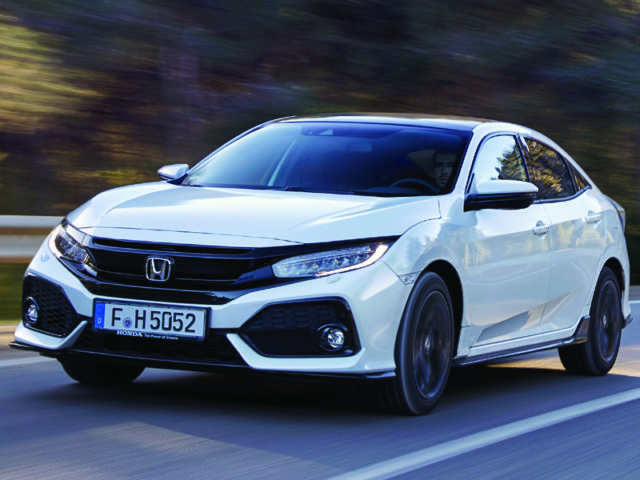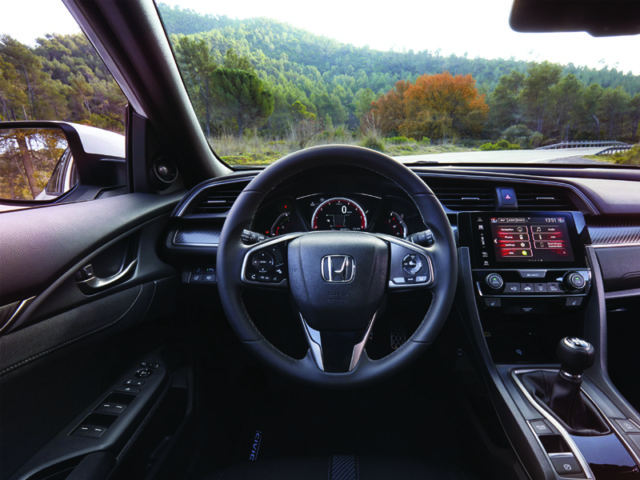Road Test: Honda Civic
The tenth-generation Civic offers plenty for fleets, but there’s a catch, says Alex Grant.
Though ‘Civic’ is a global nameplate, it’s never been a truly global car. Honda has spent the 45 years since the first generation launched engineering specific versions to suit European, Asian and North American markets. Local models often shared little more visually than the badge on the back.
Not any more. For the tenth generation, Honda channelled its global R&D talents into building a Civic to suit all markets, but based on European expectations for ride, handling, steering and refinement, reasoning that a car designed in Europe can work everywhere. So the new Civic hatch shares a platform and styling with the coupe and sedan, and cars built at the plant in Swindon in the UK will be exported globally, including to North America for the first time.
This isn’t the only break with tradition. Honda, once known for high-revving, naturally aspirated petrol engines has moved to downsizing and turbocharging. From launch, the range comprises a 129hp 1.0-litre three-cylinder and 182hp 1.5-litre four-cylinder engines, both available with a six-speed manual or continuously variable transmission. Unique to Europe, the CVT is programmed with seven stepped ‘gears’ and a system which recognises aborted overtaking manoeuvres, keeping the revs high ready for a gap to appear.
These more responsive engines are paired with a chassis focused on offering a sportier drive. The new Civic is wider, lower and significantly longer than its predecessor, built around a lighter and stiffer frame and with a quicker, more direct steering setup derived from the old Type R. Relocating the fuel tank from underneath the front seats to the more commonly-used space under the rear bench means the driving position is lower, and there’s a more sophisticated multi-link rear suspension setup at the back.
This adds up to a huge change. The Civic responds quickly and accurately to throttle and steering inputs, corners confidently and rides well. Improvements to aerodynamics mean there’s little wind noise at speed and, sat lower with the dashboard wrapped around you, it feels genuinely sporty even with the smaller of its two engines. Honda’s hardest task could be persuading drivers used to double-clutch transmissions to adopt a CVT, which is prone to droning while accelerating to higher speeds.
But that sportiness has meant compromising. The repositioned fuel tank and more sophisticated rear axle mean there’s no upwardly-folding rear bench and, if you opt for the 1.5-litre engine and either of the Sport trim levels, it loses the under-floor storage to make room for a large centre-exit exhaust. Other versions get almost the same luggage volume as the outgoing Civic, though the new car is 130mm longer overall, and all feature a clever load cover that retracts sideways so it doesn’t have to be removed if you’re folding the rear bench.
Some things haven’t changed. There’s still a spoiler and rear wiper partially obscuring the rear view, though the window itself offers a better view of low objects than most other hatchbacks. The cabin is unmistakeably Honda, too; solid and futuristic, now with a new internet-connected infotainment system featuring Apple and Android smartphone integration and the option of Garmin navigation. A package of assistance systems is standard across the range.
All of which means Honda has potential in this segment. Or, at least, it will once the line-up is complete. The 1.6-litre diesel won’t be available until later this year and there are no plans to replace the Tourer – drivers seeking either will be offered the old car, which is still being manufactured as a stop gap. Going global hasn’t curbed the Civic’s appeal in Europe, but unfortunately diesel-favouring fleets won’t find out yet.
Though ‘Civic’ is a global nameplate, it’s never been a truly global car. Honda has spent the 45 years since the first generation launched engineering specific versions to suit European, Asian and North American markets. Local models often shared little more visually than the badge on the back.
Not any more. For the tenth generation, Honda channelled its global R&D talents into building a Civic to suit all markets, but based on European expectations for ride, handling, steering and refinement, reasoning that a car designed in Europe can work everywhere. So the new Civic hatch shares a platform and styling with the coupe and sedan, and cars built at the plant in Swindon in the UK will be exported globally, including to North America for the first time.
This isn’t the only break with tradition. Honda, once known for high-revving, naturally aspirated petrol engines has moved to downsizing and turbocharging. From launch, the range comprises a 129hp 1.0-litre three-cylinder and 182hp 1.5-litre four-cylinder engines, both available with a six-speed manual or continuously variable transmission. Unique to Europe, the CVT is programmed with seven stepped ‘gears’ and a system which recognises aborted overtaking manoeuvres, keeping the revs high ready for a gap to appear.
These more responsive engines are paired with a chassis focused on offering a sportier drive. The new Civic is wider, lower and significantly longer than its predecessor, built around a lighter and stiffer frame and with a quicker, more direct steering setup derived from the old Type R. Relocating the fuel tank from underneath the front seats to the more commonly-used space under the rear bench means the driving position is lower, and there’s a more sophisticated multi-link rear suspension setup at the back.
This adds up to a huge change. The Civic responds quickly and accurately to throttle and steering inputs, corners confidently and rides well. Improvements to aerodynamics mean there’s little wind noise at speed and, sat lower with the dashboard wrapped around you, it feels genuinely sporty even with the smaller of its two engines. Honda’s hardest task could be persuading drivers used to double-clutch transmissions to adopt a CVT, which is prone to droning while accelerating to higher speeds.
But that sportiness has meant compromising. The repositioned fuel tank and more sophisticated rear axle mean there’s no upwardly-folding rear bench and, if you opt for the 1.5-litre engine and either of the Sport trim levels, it loses the under-floor storage to make room for a large centre-exit exhaust. Other versions get almost the same luggage volume as the outgoing Civic, though the new car is 130mm longer overall, and all feature a clever load cover that retracts sideways so it doesn’t have to be removed if you’re folding the rear bench.
Some things haven’t changed. There’s still a spoiler and rear wiper partially obscuring the rear view, though the window itself offers a better view of low objects than most other hatchbacks. The cabin is unmistakeably Honda, too; solid and futuristic, now with a new internet-connected infotainment system featuring Apple and Android smartphone integration and the option of Garmin navigation. A package of assistance systems is standard across the range.
All of which means Honda has potential in this segment. Or, at least, it will once the line-up is complete. The 1.6-litre diesel won’t be available until later this year and there are no plans to replace the Tourer – drivers seeking either will be offered the old car, which is still being manufactured as a stop gap. Going global hasn’t curbed the Civic’s appeal in Europe, but unfortunately diesel-favouring fleets won’t find out yet.
What we think
The Civic has become a great driver’s car with two competitive petrol engines and plenty of technology on board. But Honda’s excellent 1.6-litre diesel engine can’t come soon enough.






